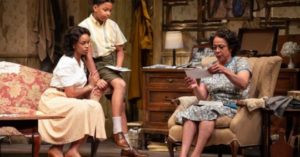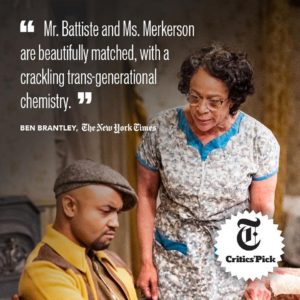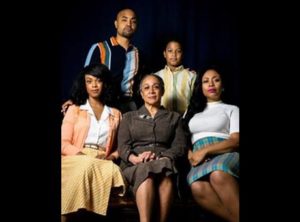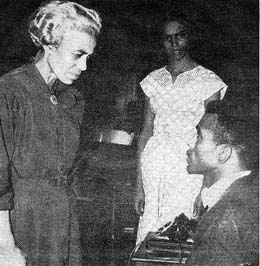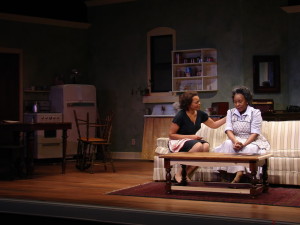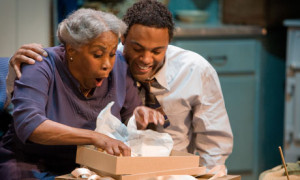Roundabout Theater Company
New York City, NY
1986
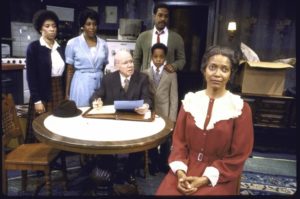
Roundabout Theater Company
New York City, NY
1986
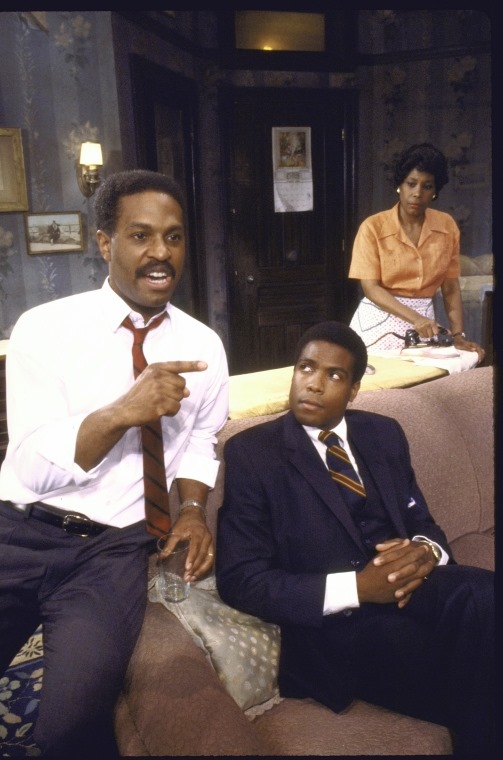
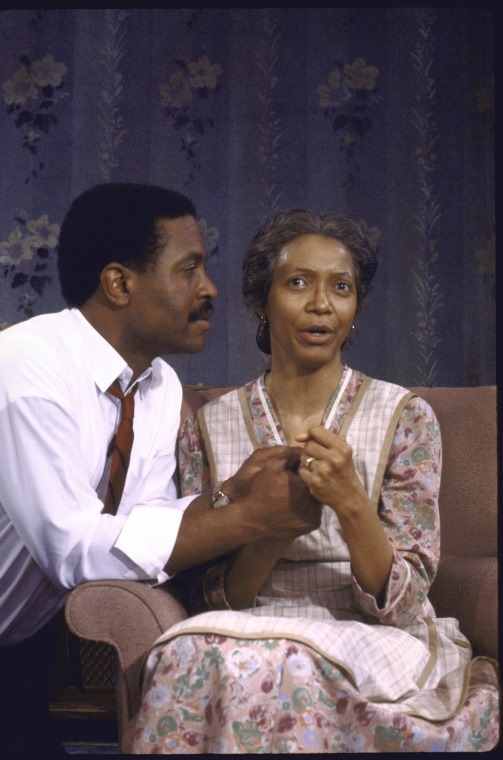
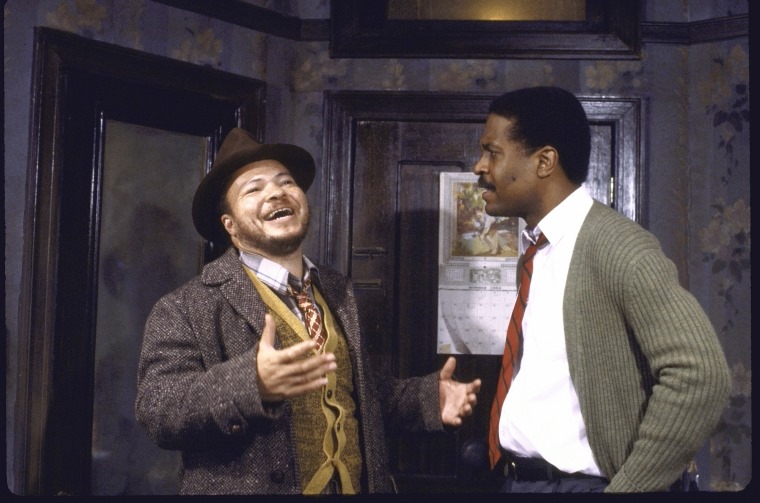
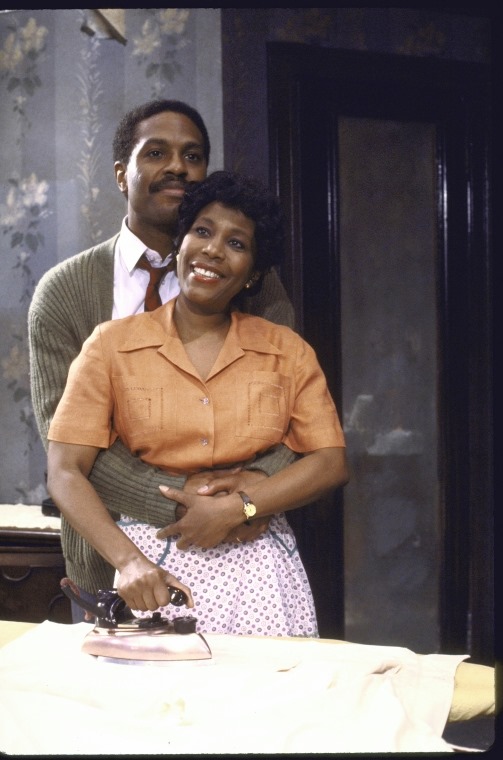
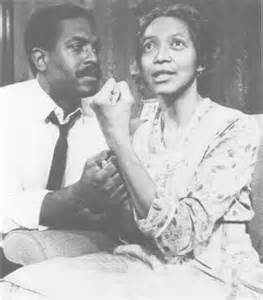
Roundabout Theater Company
New York City, NY
1986
Directed: Harold Scott
Set design: Thomas Cariello
Costume design: Judy Dearing Lighting design: Shirley Prendergast
Sound design: Rick Menke and Philip Campanella
Cast:
Ruth Younger – Starletta DuPois
Travis Younger – Kimble Joyner
Walter Lee Younger – James Pickens Jr.
Beneatha Younger -Kim Yancey
Lean Younger -Olivia Cole
Joseph Asagai-Vondie Curtis -Hall
George Murchison -Joseph C. Phillips
Bobo – Stephen Henderson
Karl Lindner -John Fiedler
Two Moving Men-Jacob Moultrie and Ron O.J. Parson
Reviews
The events of every passing year add resonance to ”A Raisin in the Sun,” Lorraine Hansberry’s play about a Black family in Chicago in the 1950s. It is as if history is conspiring to insure that the play will be a classic. And the 10 to 15 minutes of dialogue in the original that has been dropped from performance versions since the play opened on Broadway in 1959 and that is restored in the revival by the Roundabout Theatre Company make ”Raisin” seem more original, and seminal, than ever. Miss Hansberry’s prescient exploration of the conflicts over race, class, roots, women’s liberation and personal values that have transformed our thinking but not our society is so powerful that the many flaws in the play are of no consequence.
There is no danger that the audience will leave any performance of ”Raisin” not enriched, but there are some conceptual and casting problems in the revival by the Roundabout Theater Company. It is hard to avoid the notion that the director, Harold Scott, approaches the play with a little too much reverence. One of the reasons ”Raisin” is unsettling is that, for all the depth of its emotions and ideas, its structure and situations are not very different from those in ordinary soap operas. This version erases some of those similarities and thus distances the play from the audience and emphasizes the sheer brainpower of the dialogue at the cost of the emotional impact the play can have.
http://www.nytimes.com/1986/08/15/theater/stage-at-roundabout-a-raisin-in-the-sun.html?scp=10&sq=a%20raisin%20in%20the%20sun%20hansberry&st=cse
New Haven
Yale Repertory
Directed: Dennis Scott
Settings: Robert M. Wierzel
Costumes: Richard F. Mays
Lighting: Jennifer Tipton
Cast:
Ruth Younger – Mary Alice
Travis Younger – Troy Streater
Walter Lee Younger – Delroy Lindo
Beneatha Younger – Sharon Mitchell
Lena Younger – Beah Richards
Joseph Asagai – Tyrone Wilson
George Murchison – Dennis Green
Karl Lindner – Joe Ponazecki
Bobo-Mansoor Najee – Ullah
Moving Men-Tim Douglas and Courtney Vance
Reviews
All this is evident in Dennis Scott’s vibrant new staging, presented under the aegis of Lloyd Richards, artistic director of the Yale Rep and the director of the original Broadway production. Avoiding the shadow of the celebrated initial cast – Sidney Poitier, Claudia McNeil, Ruby Dee, Diana Sands, Louis Gossett Jr. – Mr. Scott is both careful and caring in his concern for the values of the script and for the individuality of his actors. The company behaves as a family – loving, arguing, and sharing home ground. The cast is exceptional, from Beah Richards and Mary Alice as Miss Hansberry’s iconographic exemplars of stalwart womanhood to the three young Yale drama students who play representatives of a forthcoming generation.
The play remains lodged in its period in language as well as the atmosphere. However, in the breadth of her concept, the playwright was prescient, touching on such issues as black nationalism and capitalism at the same time that she links her characters to their enslaved ancestors. On stage, we meet three interwoven generations of Youngers, a Black family in Chicago. Through the memories of the matriarchal grandmother, Lena, and through the rising consciousness of her granddaughter, the vision becomes a historical vista.
The artistic symbiosis of the actors, the director, and the late author carries the play past occasional sermonizing into an area of theatrical concord. In the revival, ”A Raisin in the Sun” is a heartening experience, intimately observed and communicated with integrity. At the end of the evening, one can share the elation first felt a quarter of a century ago when Miss Hansberry made her debut as a new but fully formed playwright.
http://theater.nytimes.com/mem/theater/treview.html?res=9400E4D71439F93AA35752C1A965948260&scp=13&sq=a%20raisin%20in%20the%20sun%20hansberry&st=cse
RAISIN IN THE SUN (1999) Williamstown Theater Festival.
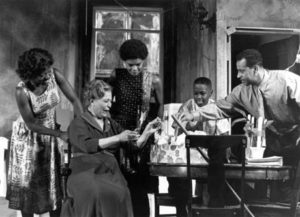
RAISIN IN THE SUN. (1999) Williamstown Theater Festival. Viola Davis, Gloria Foster, Kimberly Elise, Dion Graham, Peter Maloney, and Ruben Santiago-Hudson
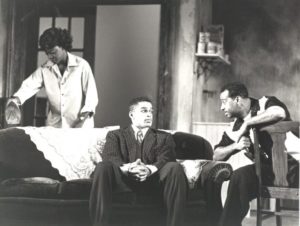
Adams Memorial Theatre
Williamstown, MA.
1999
Director: Jack Hofsiss
Set Designer: Michael McGarty
Costume Designer: Karen Perry
Lighting Designer: Rui Rita
Sound Designer: Matthew Spiro
Cast:
Ruth – Viola Davis
Bobo – Joseph Edward
Beneatha – Kimberly Elise
Lena – Gloria Foster
Joseph Asagai – Dion Graham
Karl Linder – Peter Maloney
Walter Lee – Ruben Santiago-Hudson
George – Donn Swaby
Moving Men: Andrew Coutermarsh, Andrew Leeds, Rey Lucas, and Ivan McClellan
Gospel Singers: Gina Coleman, Joseph Edward, Andrew Coutermarsh, Mya Fisher, and Rey Lucas
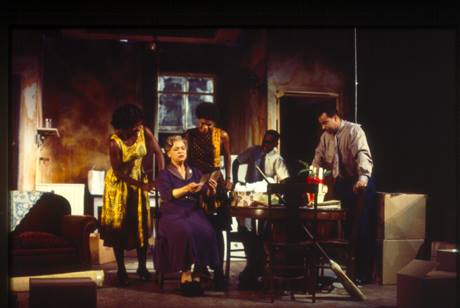
Reviews
This friction, which is given such visceral immediacy here, is the motor of Hansberry’s play and what has kept it alive long after many critics would have consigned it to the junk heap of the embarrassingly dated. In a sense, the form and structure of ”A Raisin in the Sun” are not unlike Lena herself: old-fashioned, sentimental and so domestic that it is hard to think of a scene in which a dish isn’t being washed or some laundry being ironed or folded.
But within the sturdy, kitchen-sink context there are other elements, more combustible and dynamic, that match the anxious, angry temperament of Walter Lee. Windows keep popping open in this ostensibly closed universe, admitting subversive breezes and affording larger views. Mr. Hofsiss’s production doesn’t always find the natural flow to accommodate the opposing currents of ”Raisin,” but the production still tugs at the heart.
http://theater.nytimes.com/mem/theater/treview.html?res=9c0ce4dd1f3ef93ba15754c0a96f958260&scp=27&sq=a%20raisin%20in%20the%20sun%20hansberry&st=cse
As the out-of-fashion kitchen sink style does not weaken the power and pertinence of Hansberry’s play, neither do the shortcomings of this new production at Williamstown. While not trivial, neither are they unmitigated disasters. The claustrophobic realism of the family’s Chicago tenement remains as a potent symbol of their compressed and deferred dreams. By building a more impressionist second-tier set, director Jack Hofsiss has added an interesting stab at musically linking the characters on the main set to their culture while also providing a breather from the heated dialogue in the living room below. The designers have ably supported his vision and the gospel singers who provide these between scenes mini-concerts on the darkly lit second stage are wonderful. However, while the concept of these gospel interludes is not without merit and aptness (in his adaptation of Hansberry’s To Be Young Gifted and Black, her former husband Robert Nemiroff also interspersed pieces of her work with musical fragments) when incidental music stops being incidental it tends to be intrusive, detracting from the buildup of the play’s emotional structure.
http://www.curtainup.com/raisininthesun.html
Part of its enduring power comes from its status as a prophecy. The sexual, economic and racial conflicts that shape the Younger family have not begun to subside: from Walter Lee’s frustrated struggles for financial independence and for masculine pride in a world of strong women to the quest for an African, rather than American, heritage by his sister, Beneatha (Kimberly Elise), a college student.
Whispers of the women’s liberation movement to come are heard in the gentle bristling of Walter Lee’s wife, Ruth (the wonderful Viola Davis), at her husband’s brusque domination, and in Beneatha’s determined desire to become a doctor and to avoid marriage as an answer to her problems. You can even see glimmers of the contrasting paths of the civil rights movement, passive resistance versus more aggressive action, in the approaches of Lena and Walter Lee to the family’s crises.
Most poignantly, and most universally, there is the overwhelming sense of a family under siege trying to hold together in a world that would tear it apart. Yes, the way Hansberry develops the immediate cause of dissension in the family, the question of what to do with the $10,000 insurance payment to Lena after her husband’s death, has its contrived aspects. But there is no denying the nonjudgmental clarity and compassion of her gaze as she considers the consequences.
http://theater.nytimes.com/mem/theater/treview.html?res=9c0ce4dd1f3ef93ba15754c0a96f958260&scp=27&sq=a%20raisin%20in%20the%20sun%20hansberry&st=cse
Virginia Stage Company
Wells Theatre
Norfolk, VA
March 30-April 18 2010
Director: Chris Hanna
Scenic Designer: Designer Terry Flint
Costume Designer: Jeni Schaefer
Lighting Designer: A. Nelson Ruger IV
Cast:
Ruth – Lisa Renee Pitts
Walter Lee – Wendell B. Franklin
Lena – Elain Graham
Beneatha – Nicole Gant
Joseph Asagai – Axel Avin, Jr.
George Murchinson – Matthew Cabbil
Karl Lindner – Mark Curtis
Review The most incredible thing about VSC’s production is how new the play feels. Hanna and company have managed not only to find great humanity, but also brightness, life, and humor in the play that many familiar with it may not even realize were there. For fans of the play, and especially for those with only a passing familiarity, this new production of A Raisin in the Sun is not to be missed. After all, it would be a shame to miss one of the best theatrical events of the season.
http://www.altdaily.com/features/arts/theater/a-raisin-in-the-sun.html
Statement A Raisin in the Sun is set in a cramped 1953 apartment in Southside Chicago. I believe the difficulty lies in making space feel small and uncomfortable but have enough space for the actors to move around in. Also, there must be a decision made as to how in-depth the set will be. The script calls for a living room, a small kitchen, and a few doors to unseen spaces. Depending on how detailed the set is made really determines the mood of the show. The costumes could be an issue. There is a definite line between interpreting the era and what could be considered too stereotypical. Instead of the characters being real people, the costumes could feel like an exaggeration, bringing the audience out of the show.
Not only would set be an issue for the production in general, but it also here, at Sam Houston State University. I think this show would be best done in the showcase theatre. It is small and intimate just like the play. It is an engaging show and the showcase allows for a special connection to the actors from an audience perspective. I feel as though many of the period pieces designed for at our school have been accurate and suitable for the production. The research and products of the designer would be appropriate.
Some productions have opted to make a full onset including a full kitchen look, even working sink. Others use a suggestive set with less of a kitchen area with an eat-in space leading to an open living space. Costumes were usually period and not embellished, perhaps even understated.
All of the reviews I have read commend and love the script by Lorraine Hansberry. There is a universal appreciation of the material and the very true and real place from which it was written. Most of the negatives I had read were in reference to the actors. The characters are so recognizable and iconic that it makes it hard to portray. Also, the people who have played the roles before are notable for this show and their personal careers, that it makes it hard to pull away from the predecessor’s performances. For example, the 2004 Broadway revival included Sean “P. Diddy” Combs alongside Phylicia Rashad and other experienced actors. Some reviews praised his ambitious efforts while most reviews knocked his acting and ability to get the role by his public status. Reviews also hung on the factor of realism. It is not just a story about poor, black people getting a house in a white neighborhood. Reviewers were always looking for the genuine aspect of the relationships. They wanted a sense of strength and change within the characters.
I believe that A Raisin in the Sun would not be difficult to produce; however, there would need to be great care take throughout the process
A Raisin in the Sun
Ray Fearon – Walter
Starletta DuPois – Lena
Jenny Jules – Ruth
Tracy Ifeachor – Benatha
Royal Exchange – Manchester
A RAISIN IN THE SUN
by Lorraine Hansberry
JUNE 25 – JULY 13 |2019 – MAIN STAGE
2019 SEASON
By Lorraine Hansberry
Directed by Robert O’Hara
With Francois Battiste, Kyle Beltran, Joshua Echebiri, Eboni Flowers, Joe Goldammer, Mandi Masden, Nikiya Mathis, S. Epatha Merkerson, Warner Miller, Owen Tabaka
[ Photos by Joseph O_Malley ]
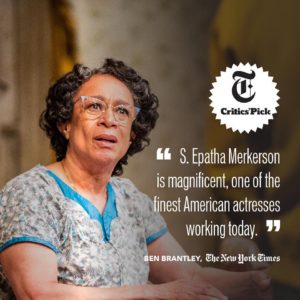
Williamstown Theater Festival
A RAISIN IN THE SUN
by Lorraine Hansberry
JUNE 25 – JULY 13 |2019 –
